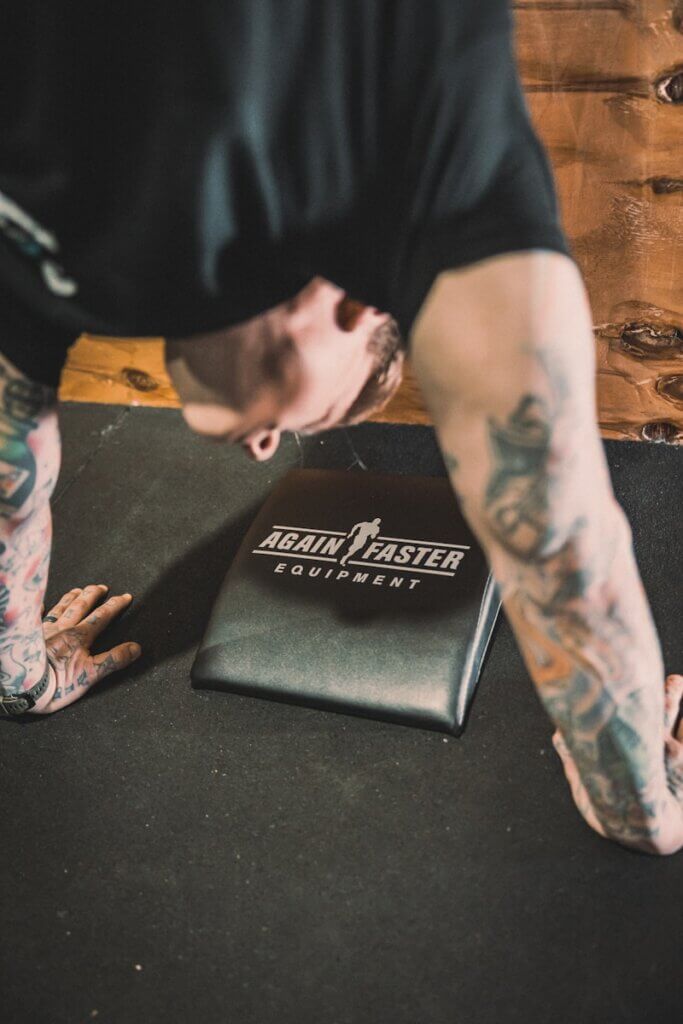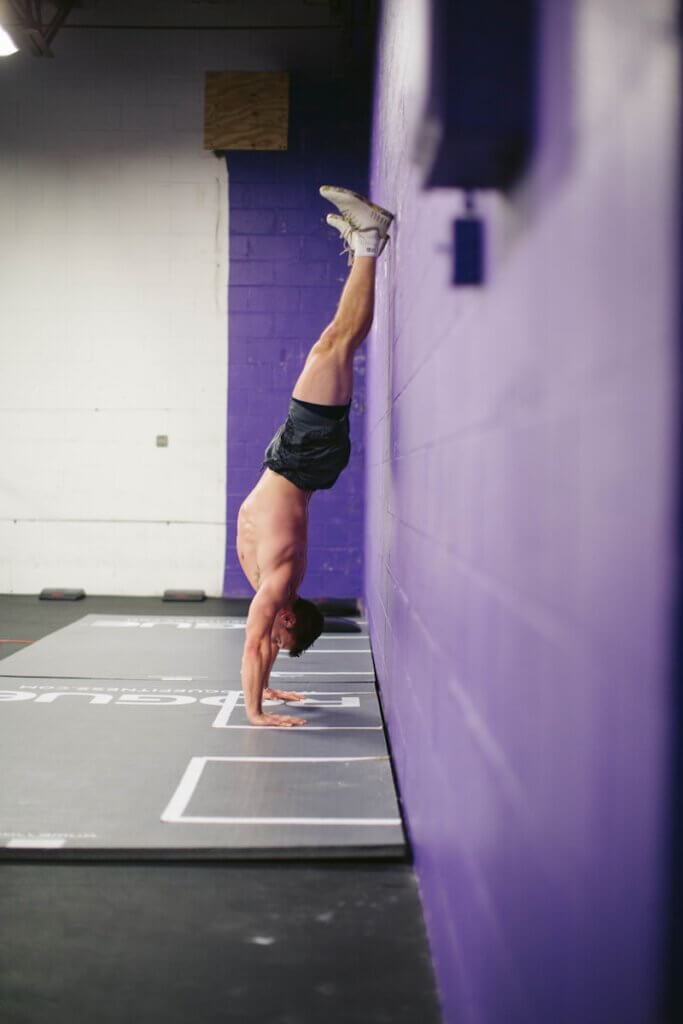How to do Handstand Hold

Introduction:
The handstand hold is a quintessential bodyweight exercise that epitomizes strength, balance, and control. Whether you’re aiming to conquer your fear of going upside down or seeking to enhance your athleticism and body awareness, the handstand hold offers a myriad of benefits for individuals of all fitness levels. In this comprehensive guide, we’ll explore the intricacies of the handstand hold, providing step-by-step instructions, essential equipment, scaling options, common mistakes to avoid, and the numerous benefits of incorporating this challenging yet rewarding exercise into your training routine.
Steps in the Handstand Hold movement
- Preparation: Begin in a kneeling position with your hands placed shoulder-width apart on the ground, fingers spread wide for stability.
- Kick Up: Shift your weight forward onto your hands and kick one leg upward, aiming to bring your hips over your shoulders and eventually aligning your body vertically against the wall.
- Find Balance: Engage your core muscles to stabilize your body and maintain balance in the handstand position.
- Hold: Once you’ve achieved a vertical position, hold the handstand for the desired duration, focusing on maintaining a straight body line from wrists to ankles.
- Controlled Descent: Lower one leg down at a time to return to the starting position, maintaining control and stability throughout the movement.
What Equipment is needed for Handstand Holds
- Wall: A sturdy wall is essential for practicing handstand push-ups, as it provides support and stability during the movement.
- Gymnastics mat (optional): Placing a mat under your head can provide cushioning and protection. An Abmat or specialized handstand push up mat can be used.
- A box can be used for scaled versions of the handstand hold.
- Chalk, so not to slip with the hands.
Incorporating Handstand Equipment
While handstand holds can be performed without equipment, certain tools can facilitate learning and improve technique. Parallettes, for example, elevate the hands and reduce wrist strain, making them beneficial for beginners. Handstand blocks can aid in balance training by providing a stable yet elevated surface to grip. For those looking to refine their skills further, handstand canes offer an additional challenge by increasing the height and instability, thus enhancing balance and control. Investing in quality equipment can accelerate progress and provide a safer practice environment.
Check out the Equipment subsite for more tools, tips, and inspiration.

Shop Fitness gear now on Amazon
See Amazons extensive range of workout gear here. (Affiliate Link)
Scaling Options:
To gradually build strength and proficiency, consider the following scaling options:
- Wall-assisted handstand: Practice handstand holds with your feet resting against a wall for support and stability.
- Frog stand: Begin with a frog stand, balancing on your hands with your knees tucked into your chest, before progressing to full handstand holds.
- Partner assistance: Have a spotter assist you by holding your legs or providing verbal cues for balance and alignment.
Progressive Training Plan
Developing the strength and balance required for a handstand hold involves a structured training plan. Start with foundational exercises like plank holds and pike presses to build core and shoulder strength. Progress to wall-assisted handstands, gradually reducing reliance on the wall as balance improves. Incorporate balance drills, such as shifting weight between hands while in a handstand position, to enhance proprioception. Aim to practice handstands 3-4 times per week, allowing adequate rest between sessions. Consistency and gradual progression are key to safely achieving a freestanding handstand hold.
Common Mistakes to Avoid:
- Arched back: Maintain a hollow body position with your core engaged and ribs drawn in to prevent excessive arching of the lower back.
- Over-kicking: Control the momentum of your kick-up to avoid overshooting the handstand position, which can lead to loss of balance and instability.
- Neglecting hand placement: Ensure your hands are positioned shoulder-width apart and rooted firmly into the ground, distributing weight evenly across the palms to maintain stability.
Benefits of the Movement:
- Strengthens Upper Body: Builds shoulder, arm, and core strength, as well as wrist stability, through weight-bearing on the hands.
- Improves Balance and Coordination: Challenges proprioception and spatial awareness, enhancing overall balance and coordination.
- Boosts Confidence: Overcoming the fear of going upside down and mastering the handstand hold can instill a sense of accomplishment and confidence in your abilities.

Which Muscles Are Worked:
During this exercise, the following muscle groups are engaged:
- Primary Muscles: Shoulders, arms (triceps and forearms), core (abdominals and lower back)
- Secondary Muscles: Chest, upper back, glutes, hamstrings
Alternative Similar Movements:
If you’re seeking variation or targeting specific muscle groups, consider incorporating these alternative exercises:
- Handstand push ups
- Kipping handstand push ups
- Pike push-ups
- Shoulder presses

Shop Fitness gear now on Amazon
See Amazons extensive range of workout gear here. (Affiliate Link)
Warm-Up and Mobility Exercises
Before attempting handstand holds, it’s crucial to prepare your body adequately to prevent injuries and optimize performance. Begin with general cardiovascular activities, such as light jogging or jumping jacks, to increase blood flow. Follow this with dynamic stretches focusing on the shoulders, wrists, and hamstrings. Exercises like arm circles, wrist flexor stretches, and leg swings can enhance flexibility and range of motion. Incorporating shoulder mobility drills, such as shoulder dislocates using a resistance band, can further prepare the joints for the demands of a handstand. Spending 10-15 minutes on a thorough warm-up can significantly improve your handstand practice and reduce the risk of strain.
Breathing Techniques and Mental Focus
Mastering the handstand hold requires not only physical strength but also mental focus and proper breathing. Maintaining a calm and steady breath helps stabilize the body and provides the muscles with necessary oxygen. Practice diaphragmatic breathing, inhaling deeply through the nose and exhaling through the mouth, to maintain composure while inverted. Visualization techniques can also aid in achieving balance; imagine a straight line extending from your wrists through your toes, and focus on this alignment during the hold. Developing a mindful approach to your handstand practice can enhance concentration and performance.
Safety Precautions and Injury Prevention
Safety should be a primary concern when practicing handstand holds. Ensure you practice in a clear area free from obstacles, with a soft surface like a gymnastics mat to cushion any falls. It’s advisable to have a spotter when first attempting freestanding handstands to provide assistance and prevent accidents. Listen to your body and avoid pushing through pain; if you experience discomfort, especially in the wrists or shoulders, take a break and assess your technique. Regularly performing wrist and shoulder strengthening exercises can also aid in injury prevention. Prioritizing safety will lead to a more sustainable and enjoyable handstand practice.
Q&A for Handstand holds
How to get a handstand hold?
Start with wall-assisted handstands to build strength and balance. Gradually progress to free-standing handstands by practicing kick-ups and finding your balance away from the wall.
Why can’t I hold a handstand?
Inability to hold a handstand can stem from insufficient strength, poor balance, or improper technique. Consistent practice, focusing on core engagement and proper alignment, can help improve your hold.
Are handstand holds a good workout?
Yes, handstand holds are excellent for building upper body and core strength. They also improve balance and coordination, making them a valuable addition to any workout routine.
Where to look when holding a handstand?
Look slightly forward between your hands, not directly at the ground. This helps maintain neck alignment and balance.
Is holding a handstand for 5 seconds good?
Yes, holding a handstand for 5 seconds is a great achievement for beginners. With practice, you can increase your hold time.
Can handstands give you abs?
Handstands engage the core muscles, contributing to abdominal strength and definition. They are effective for developing overall core stability.
How long can you safely hold a handstand?
Hold a handstand for as long as you can maintain proper form and feel comfortable. Beginners might start with a few seconds, gradually increasing as strength and balance improve.
How strong do you need to be to hold a handstand?
You need a solid foundation of shoulder, arm, and core strength to hold a handstand. Exercises like push-ups, planks, and shoulder presses can help build the necessary strength.
How do I know if I’m strong enough to do a handstand?
If you can hold a plank for at least a minute and perform several push-ups with good form, you likely have the strength needed for a handstand. Practicing against a wall can also help gauge your readiness.
Is handstand a skill or strength?
Handstands require both skill and strength. Proper technique, balance, and body control are essential, along with sufficient upper body and core strength.
How long does it take to master handstand hold?
The time it takes to master a handstand hold varies depending on individual strength, balance, and practice consistency. It can take several weeks to several months of dedicated practice.
Why is handstand so difficult?
Handstands are challenging because they require a combination of strength, balance, coordination, and overcoming the fear of being upside down. Consistent practice and proper technique are key to mastering them.
Conclusion:
Mastering the handstand hold requires patience, practice, and perseverance. By incorporating this challenging yet exhilarating exercise into your training routine, you can enhance your strength, balance, and body control while unlocking new levels of athleticism and confidence. So, embrace the journey, defy gravity, and discover the empowering sensation of standing tall on your hands!

Shop Fitness gear now on Amazon
See Amazons extensive range of workout gear here. (Affiliate Link)

🏋️ Written by: Mike Kerr
Mike is the founder of Strengthguides.com and a certified CrossFit Level 1 Trainer (CF-L1) and certified Kettlebell Instructor with over 10 years of experience in functional fitness. He specializes in developing programs that maximize performance without sacrificing mobility. Mike Kerr is passionate about making complex training methodologies comprehensible and safe for everyone.
